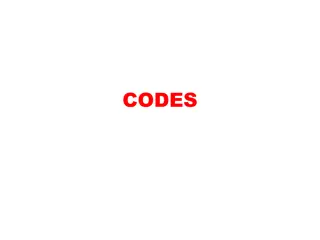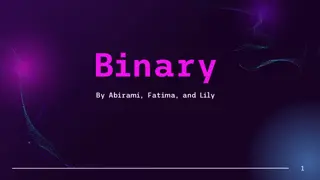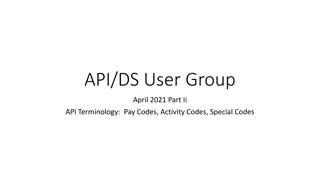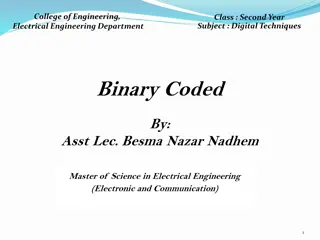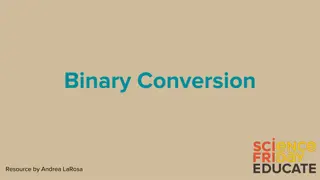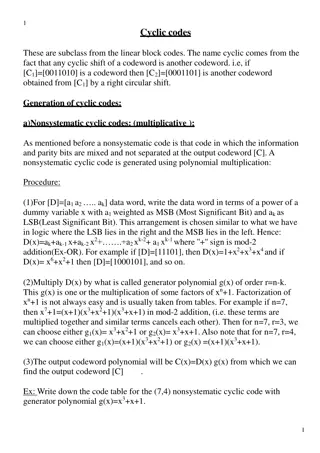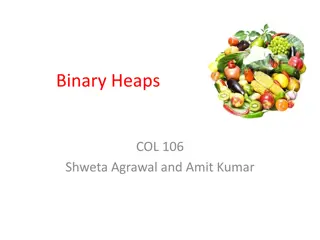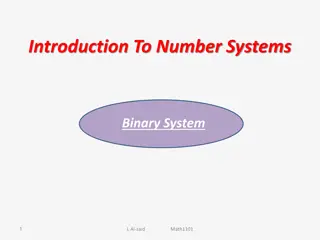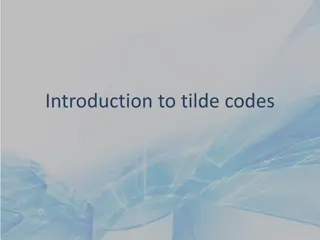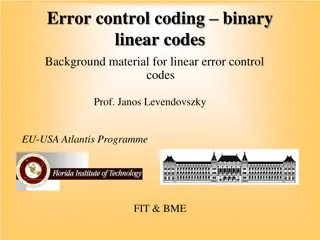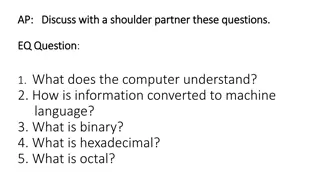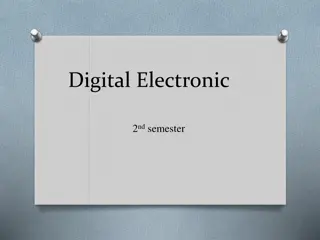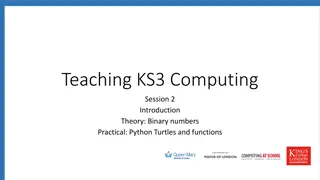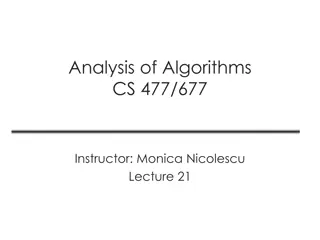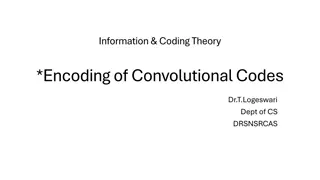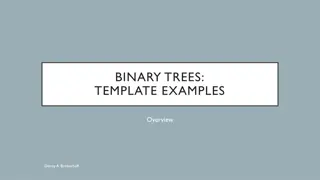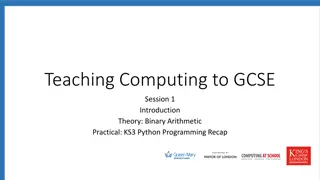Binary Codes and Their Applications
Binary coding is crucial for digital systems as they understand only 0s and 1s. This process converts information into binary language for processing by digital circuits. Different types of binary codes like weighted codes and BCD codes are used for error correction, digital communication, and compu
8 views • 20 slides
Non-Weighted Codes and Excess-3 Code in Binary Systems
Explore non-weighted binary codes like Excess-3 code, learn how to convert decimal numbers to XS-3 code, advantages and disadvantages of BCD codes, and steps to convert Excess-3 code to binary. Discover the intricacies of binary coding systems with practical examples.
7 views • 55 slides
Binary Number System and its Applications
Explore the world of binary numbers with insights on what binary is, its significance in computing, conversion methods between binary and decimal, hexadecimal number system, and binary arithmetic operations. Dive into the foundations of digital communication through the language of zeros and ones.
3 views • 24 slides
API/DS User Group
Dive into the terminology surrounding Activity Codes, Pay Codes, and Special Codes within the realm of APIs. Explore how these codes represent different aspects of scheduling, productivity, and payroll management. Gain insights into the distinctions between Activity Codes and Pay Codes, their implic
6 views • 8 slides
Binary Codes and Self-Complementing Codes
The concept of binary codes, including Binary Coded Decimal (BCD) codes, and self-complementing codes is explored in this informative content. Learn about how decimal numbers are represented in binary form, the structure of BCD codes, and the properties of self-complementing codes like 2421 and Exce
5 views • 34 slides
Binary Coded Decimal (BCD) and Excess-3 Code
Binary Coded Decimal (BCD) is a binary code used to represent decimal numbers, with the popular 8421 BCD code and its conversion process explained. Additionally, Excess-3 Code, another BCD code, is detailed with an example of finding its code for a given decimal number. Different BCD codes like 4221
13 views • 11 slides
Binary Code and Color Conversion
Delve into the fascinating world of binary code and learn how it works to represent data digitally. Discover the process of decoding binary pulses into colored pixels, using binary sequences to identify colors, and practicing digital-analog conversion through logic maps. Explore the language of bina
3 views • 20 slides
Cyclic Codes: Generation and Examples
Cyclic codes are a subclass of linear block codes where any cyclic shift of a codeword results in another valid codeword. This article explains the generation of nonsystematic cyclic codes through polynomial multiplication and provides examples and code tables for both nonsystematic and systematic c
2 views • 11 slides
Binary Heaps: Efficient Data Structure for Priority Queue Operations
Explore the concept of binary heaps, a specialized type of binary tree that allows for quick retrieval of the smallest (or largest) element. Learn how binary heaps excel in finding the minimum value, essential for priority queue applications in operating systems, event simulations, and more. Compare
3 views • 34 slides
Binary Logic Systems in Documentation
Binary logic systems play a crucial role in documentation for individuals with diverse backgrounds such as management, process designers, operations staff, maintenance technicians, and more. These systems, depicted in binary logic diagrams, provide a clear and concise representation for various prof
7 views • 16 slides
Converting Left Linear Grammar to Right Linear Grammar
Learn about linear grammars, left linear grammars, and right linear grammars. Discover why left linear grammars are considered complex and how right linear grammars offer a simpler solution. Explore the process of converting a left linear grammar to a right linear grammar using a specific algorithm.
5 views • 44 slides
Binary Number System in Mathematics
Delve into the intricacies of the binary number system with this comprehensive guide. Learn how binary numbers are formed, and master the conversion techniques between binary and decimal numbers. Discover the fascinating world of binary fractions and the algorithms for converting decimal numbers to
28 views • 20 slides
Introduction to Binary Arithmetic for Digital Electronics
Binary arithmetic is fundamental in digital electronics, involving addition, subtraction, and multiplication of binary numbers. This guide explains the rules and examples of binary arithmetic operations, such as binary addition and subtraction, along with detailed steps and illustrations for better
0 views • 21 slides
Binary Codes and Character Coding Techniques
Binary codes, such as ASCII and EBCDIC, are crucial in representing data in computers and digital systems. They play a key role in error detection and data encoding. This article discusses the basics of binary coding, various types of binary codes, character coding techniques like ASCII and EBCDIC,
21 views • 22 slides
Quantum Error-Correcting Codes and Subsystem Codes
Quantum error-correcting codes (QECC) play a crucial role in protecting quantum information from errors. Stabilizer codes with fault-tolerant error-detecting circuits can lead to the construction of resilient subsystem codes. These codes involve encoding logical qubits into physical qubits and error
3 views • 26 slides
Tilde Codes for Custom Result Pictures
Tilde codes are utilized in the creation of custom result pictures from a mentometer system, offering flexibility in formats and colors. These codes are embedded within result pictures and replaced with numerical values by the mentometer system. Learn how to hide/unhide tilde codes, commonly used ti
5 views • 21 slides
Binary Representation of Numbers with Fractions
Learn how to represent numbers with fractions in binary form. Discover the process of converting real numbers, like 5.75, into binary by separating the integer and fraction parts. Explore the method of obtaining the binary representation of the fraction through division by specific decimal values. U
1 views • 21 slides
Linear Error Control Coding and Syndrome Detection in Binary Linear Codes
Delve into the world of linear error control coding, guided by Prof. Janos Levendovszky, as we explore the development of linear codes, message vectors, error groups, and the process of selecting group leaders with detailed examples. Discover how syndrome detection and decoding tables play a crucial
3 views • 27 slides
Binary Numbers and Computer Data Representation
A computer stores information digitally as binary numbers, where data is broken down into pieces and represented as numbers. The binary system uses 0s and 1s to encode information, with each bit representing on/off states. This system is crucial for converting data into machine language. Binary numb
1 views • 14 slides
Conversion from Decimal Numeration to Binary, Octal, Hexadecimal
In digital electronic studies, understanding the conversion from decimal numeration to binary, octal, and hexadecimal systems is crucial for computer science enthusiasts. This process involves repeated cycles of divisions to break down the decimal number into binary, octal, or hexadecimal place weig
21 views • 15 slides
Binary Numbers
Dive into the world of binary numbers, exploring how they can be used efficiently for counting and mastering the art of conversion between binary and decimal numbers. Discover the logic behind binary digits and how they power modern technology and computing systems. Unveil the simplicity and eleganc
2 views • 14 slides
Teaching KS3 Computing
Today's session covers binary numbers, teaching how they are represented, and enabling students to perform binary-to-decimal conversions with practical examples and activities. Explore binary counting exercises, conversion techniques, and practice exercises to enhance understanding. Activities inclu
1 views • 20 slides
Digital Electronic
Israa Hussein's 2nd semester lecture on digital electronic systems explores the comparison between binary and decimal numeration systems. Delve into the representation of quantities in binary, the ease of materializing 0 and 1 in electronics, and the binary equivalent of numbers like 35. Understand
0 views • 18 slides
Binary Representation Basics
Delve into the fundamentals of binary number representation as explained in the instructional material from William Marsh School of Electronic Engineering and Computer Science at Queen Mary University of London. Learn how to count and perform arithmetic in binary, understand the significance of bina
0 views • 34 slides
8086 Architecture and Binary Numbering System
Explore the fundamentals of 8086 architecture and binary numbering system. Delve into how computers interpret binary digits, the significance of bits, nibbles, bytes, words, and double words, and the conventions for denoting binary numbers. Learn binary addition and subtraction with examples.
3 views • 6 slides
Huffman Codes for Data Compression: Analysis and Implementation
Huffman codes are a widely used technique for data compression, assigning binary codes to characters based on their frequency of occurrence. This lecture series delves into fixed-length codes, variable-length codes, and prefix codes, explaining their optimization and implementation for efficient dat
3 views • 31 slides
Practice Now: Binary & Denary Conversion
Convert binary numbers to denary and vice versa using mini whiteboards or scrap paper. Master converting binary numbers like 10011001 to denary, 103 to binary, 5C to binary, and F9 to denary. Increase your computational skills with these exercises.
5 views • 25 slides
RECURSIVE DATATYPES
Recursive datatypes play a crucial role in defining complex data structures such as binary trees. This content delves into the concept of recursive datatypes, specifically focusing on binary trees and their node structures. Each node in a binary tree contains a value and two other binary trees, illu
0 views • 10 slides
Encoding and Decoding of Convolutional Codes in Information Theory
In the realm of information and coding theory, Convolutional Codes serve as error-correcting codes essential for digital communication systems. This article delves into the encoding and decoding processes of Convolutional Codes, highlighting their significance in transmitting continuous data streams
4 views • 38 slides
Huffman Codes for Data Compression
Explore the concept of Huffman Codes in data compression, learn about prefix codes, binary character codes, and the greedy algorithms used for optimal compression. Discover the top-down and bottom-up approaches, and see how to create efficient prefix trees for encoding data.
7 views • 26 slides
Fundamentals of Block Codes in Information Theory
Discover the fundamentals of block codes in information theory, including definitions, parameters, codewords, error detection and correction, linear block codes, types of block codes, decoding algorithms, and code parameters. Learn how block codes play a crucial role in ensuring reliable communicati
2 views • 9 slides
Binary Codes in Digital Electronics
Explore the world of binary codes in digital electronics, including BCD, Excess-3, Gray codes, and ASCII codes. Learn about the advantages of binary coding and the classification of binary codes into weighted, non-weighted, BCD, alphanumeric, error detecting, and error correcting codes.
1 views • 14 slides
Signed Binary Numbers and Binary Codes in Digital Electronics
Learn how signed binary numbers are represented in digital electronics using sign-magnitude form, understand the concept of sign-1's complement, and explore examples to grasp the fundamentals of binary representations for both positive and negative numbers.
1 views • 12 slides
Binary Trees Template Examples and Implementation Guide
Delve into the world of binary trees with detailed examples and a comprehensive guide on creating, manipulating, and removing nodes in binary tree structures. Learn the step-by-step process for implementing binary trees and efficiently managing tree nodes. Explore various scenarios for removing node
0 views • 10 slides
Introduction to Trees and Binary Search Trees
Today's lecture covers topics related to trees, including binary trees and binary search trees. Learn about level-order traversal, in-order traversal, and the concept of binary search trees. Discover efficient operations supported by binary search trees for key insertion, search, and removal.
2 views • 66 slides
Teaching Computing: Binary Arithmetic and Python Programming Overview
This session introduces GCSE students to binary arithmetic theory and practical Python programming skills. Topics covered include adding binary numbers, binary shifts, logic diagrams, CPU architecture, arrays, and more. Prepare for GCSE programming with longer tasks and consolidate understanding thr
4 views • 22 slides
Understanding Binary Code and Number Representation in Coding
Explore the world of binary code and number representation in coding through examples like writing numbers in binary, comparing decimal numbers with binary code, and understanding how binary values work. Discover the relation between binary values and decimal numbers in a visual and interactive mann
1 views • 15 slides
Converting Left Linear Grammar to Right Linear Grammar
Learn how to convert a left linear grammar to a right linear grammar. Understand the concepts of linear grammars, left linear grammars, and right linear grammars. Discover why left linear grammars are considered complex and why right linear grammars are more favorable. Explore the algorithm used for
3 views • 44 slides
Understanding Binary Files in Programming
Learn about the importance of binary files in programming, how they differ from human-readable text files, and how to work with them efficiently. Explore concepts such as binary mode for file opening, reading binary data using fread(), and writing binary data with fwrite().
4 views • 31 slides
Embedded Systems Lecture on Fixed Point Arithmetic and Binary Numbers
Explore the concepts of fixed point arithmetic and binary numbers in this advanced embedded systems lecture. Learn how to convert binary to decimal values and understand the representation of numbers to the right of the binary point. Discover techniques for converting numbers like 1.53125 into binar
25 views • 32 slides
